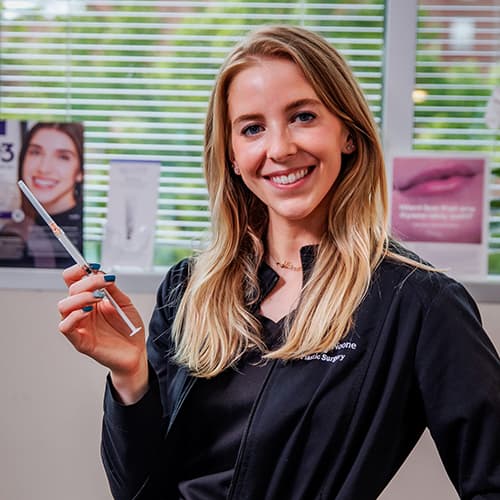Dysport® (Neuromodulator)
What is Dysport?
Dysport® is a form of botulinum toxin type A (abobotulinumtoxinA) used to temporarily reduce the appearance of moderate to severe glabellar lines (frown lines between the eyebrows).
How does Dysport work?
Over time, our repeated facial movements can cause fine lines and wrinkles to form, especially in our brow and forehead. Dysport is injected into the brow muscles to temporarily block the signals between nerves and muscles that cause lines to form in this area. Once injected, Dysport immediately goes to work smoothing wrinkles and fine lines.
Full results from Dysport are typically visible within 7 days, and last for approximately 3 to 4 months. We recommend patients receive injections every 3 to 4 months to maintain optimal results.
What can Dysport treat?
Dysport is FDA approved to treat moderate to severe glabellar lines (also known as the “11s”). There are 5 main points along the brow where your provider will inject Dysport to minimize the appearance of glabellar lines (as seen below).

In addition to frown lines, Dysport is also effective at treating the following:
- Forehead lines.
- Crow’s feet.
- Abnormal muscle spasms in the neck, eyelids, and limbs.
Dysport vs. Botox®
Dysport and Botox® are both neuromodulating drugs used to temporarily smooth lines and wrinkles in the face, but the two products have some slight differences:
- Dysport may work slightly faster than Botox (2 to 5 days vs. 4 to 7 days).
- Dysport disperses wider than Botox due to its molecular size, meaning it may have a slightly larger treatment area.
- Both Botox and Dysport results typically last for 3 to 4 months, but Botox can last up to 6 months.
- Botox and Dysport are measured in different units (1 unit of Botox equals 2.25 units of Dysport).
Julie Holesh, PA
Physician assistant Julie Holesh is board-certified by the National Commission on Certification of Physician Assistants. With both an artistic eye and medical expertise, she can help you achieve optimal skin quality with injectables, laser treatments, and other med spa services.
Am I a good candidate for Dysport?
You may be a good candidate for Dysport if you meet the following criteria:
- You are not allergic to botulinum toxin type A.
- You avoid taking the following medications prior to your Dysport injections: aminoglycosides, anticholinergics, curare alkaloids, and muscle relaxants.
- You avoid taking blood thinning medications like ibuprofen and acetaminophen 2 weeks prior to your treatment, as they can increase your risk of bruising.
- You avoid alcohol 24 hours prior to treatment. Alcohol is a blood thinner, which may increase your risk of bruising.
- You do not have a milk allergy (Dysport contains a milk-derived protein called albumin).
Have questions? Dr. Claytor can help you determine whether you’re a good candidate for Dysport during a personal consultation.
Does Dysport have any side effects?
Dysport side effects are typically mild and resolve themselves quickly. The most common side effects with Dysport are swelling, redness, and headache. You can reduce any risks of complications by choosing a Board Certified Plastic Surgeon.
- Key Benefits
- Glossary
- Quick treatments that can be performed on a lunch break
- Little to no downtime
- Softens dynamic wrinkles in the upper face
- Prevents worsening wrinkles
Botulinum Toxin Type A: The active ingredient in Dysport, which temporarily blocks nerve signals to muscles to reduce the appearance of wrinkles.
Glabellar Lines: Vertical frown lines between the eyebrows, often targeted by Dysport injections.
Cervical Dystonia (CD): A painful condition characterized by neck muscle contractions, sometimes treated with Dysport.
AbobotulinumtoxinA: The non-proprietary name for the purified botulinum toxin in Dysport.
Neuromodulator: A substance, like Dysport, that alters nerve impulse transmission, often used in aesthetics to relax muscles and reduce wrinkles.
OnabotulinumtoxinA: The active ingredient in Botox, another botulinum toxin product often compared to Dysport.
Reconstitution: The process of adding a liquid (like saline) to Dysport powder to prepare it for injection.
Unit: The measurement used to quantify Dysport or other botulinum toxin products for dosing purposes.
Dilution: Adjusting the concentration of Dysport through the addition of liquid, affecting the units of product administered.
Injection Sites: Specific areas on the face or body where Dysport is injected to achieve the desired aesthetic or therapeutic effect.
Contraindications: Conditions or factors that make Dysport use inadvisable, like certain medical conditions, allergies, or medication use.
Adverse Reactions: Unwanted side effects or responses to Dysport, ranging from mild to severe.
Hyperhidrosis: Excessive sweating, which can sometimes be treated with Dysport.
Duration of Effect: The expected time frame for which Dysport’s effects are visible or noticeable.
Maintenance Treatment: Ongoing Dysport injections scheduled to sustain or improve upon the initial treatment results.
About your Dysport treatment
Before your Dysport injections, our aesthetics team will apply a topical numbing cream to your treatment area. The number of units your doctor will use depends on the area being treated and your desired results. You may feel a slight pinch from the needle, but most patients describe this procedure as comfortable. Dr. Claytor and our experienced Physician Assistant, Julie Holesh, typically perform Dysport treatments in 10 minutes or less, making it the perfect “lunchtime treatment.” It is common for patients to experience some minor swelling around their injection site, but this normally dissipates within 1 to 2 hours.
Enhance your at-home routine:
Boost skin rejuvenation with Omnilux LED Masks
Extend the glow of your in-office treatments with Omnilux, a professional-grade LED light therapy system you can use at home. These FDA-cleared, flexible masks use red and near-infrared light to:
- Stimulate collagen
- Reduce fine lines
- Calm inflammation
- Heal and prevent acne
- Treat under-eye puffiness
- And more!
Omnilux can support healing and enhance your results between your treatment visits with just 10 minutes a few times per week!
Learn more and get your device »
Restore thicker, fuller hair with Nutrafol hair growth supplements
Address the deeper causes of hair thinning—like stress, hormone fluctuations, or nutrient deficiencies—with Nutrafol, a clinically backed, natural supplement that works from within to support stronger, fuller hair. Available in targeted formulas for women, men, postpartum, and even vegan options, Nutrafol can help extend the benefits of your treatment beyond the skin.
Learn more about Nutrafol and how it works »
Schedule your Main Line Dysport consultation todayBoard certified plastic surgeon Dr. R. Brannon Claytor and our highly trained Physician Assistant Julie Holesh administer Dysport, Botox, DAXXIFY, and Xeomin injections. Dysport injections are performed in the safety and comfort of our private surgical office, meaning patients can be back to their daily activities immediately following their treatment. To learn more about Dysport and to schedule your consultation, contact us online or call (610) 527-4833.
References »
Schlessinger J, Gilbert E, Cohen JL, Kaufman J. New Uses of AbobotulinumtoxinA in Aesthetics. Aesthetic Surgery Journal. 2017 May 1;37(suppl_1):S45-S58. doi: 10.1093/asj/sjx005.
Gart MS, Gutowski KA. Overview of Botulinum Toxins for Aesthetic Uses. Clinics in Plastic Surgery. 2016 Jul;43(3):459-71. doi: 10.1016/j.cps.2016.03.003.
Flynn TC. Botulinum toxin: examining duration of effect in facial aesthetic applications. American Journal of Clinical Dermatology. 2010;11(3):183-99. doi: 10.2165/11530110-000000000-00000.
Green JB, Mariwalla K, Coleman K, Ablon G, Weinkle SH, Gallagher CJ, Vitarella D, Rubio RG. A Large, Open-Label, Phase 3 Safety Study of DaxibotulinumtoxinA for Injection in Glabellar Lines: A Focus on Safety From the SAKURA 3 Study. Dermatologic Surgery. 2021 Jan 1;47(1):42-46. doi: 10.1097/DSS.0000000000002
Areas Served:

Medically reviewed by Dr. R. Brannon Claytor — Updated on Apr 9, 2025


